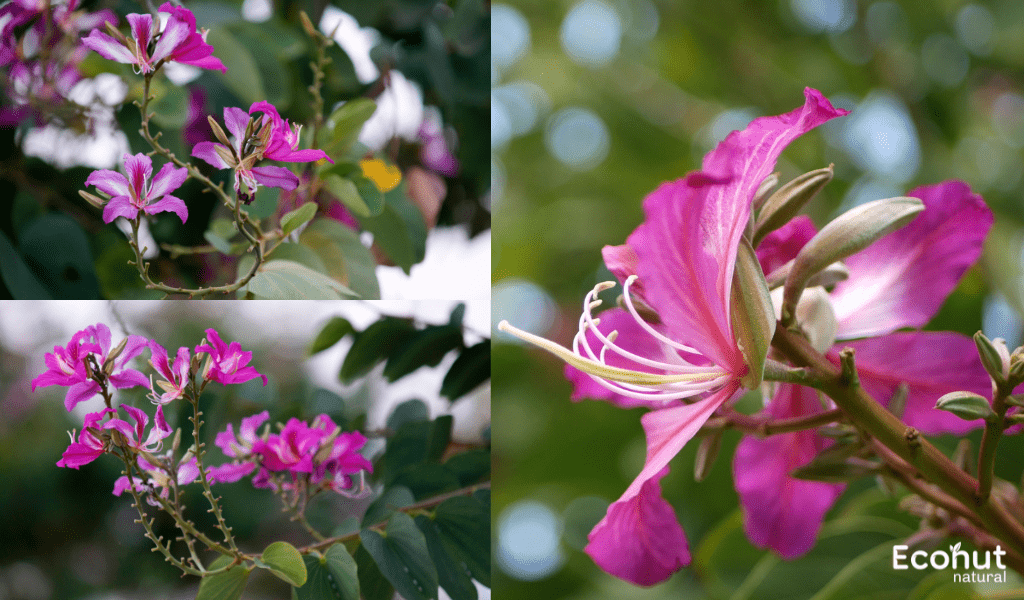Kachnar (Bauhinia Variegata)is a member of the Fabaceae family. Kachnar, (Bauhinia Variegata) also known as Bauhinia variegata, is a multipurpose tree. You can eat the blooms and the buds. Its bark is utilized as medicine in Ayurveda. It is also a valuable plant for feed. Its leaves are given to cattle. Shoots are chopped in the fall and fed to cattle as green manure.
The kachnar tree is a deciduous tree that can grow to a height of 15 meters or less. It has a short bole and a spreading crown. The tree’s twigs are hairy, angled, light green, and brownish-grey in hue. The inner bark is pinkish in color, fibrous, and bitter, while the outside bark is scaly, smooth to slightly fissured and brownish grey in color.
Description
kachnar (Bauhinia Variegata) grows abundantly in steep regions, it is also known as mountain ebony. The term “variegata” refers to a species of plant that has colored patches on it. One of the most often utilized herbs in Ayurveda is kachnar.
Botanical Name:
Bauhinia Variegata
Family:
Fabaceae
Leaves:
The leaves are obcordate in shape, rounded, long and broad, and bilobed at the base and tip, measuring 10–20 centimeters (3.9–7.9 in).
Flowers:
It produces a large number of stunning, fragrant, five-inch-wide blooms, with slender petals that range in color from bright pink to white and arranged to nearly resemble orchids.
Fruits:
Pods or legumes, flat, glabrous, 15–30 × 15–25 cm
Seeds:
Kanchnar pods have a large number of seeds, roughly 10 to 15.
Habitat:
Kachnar, (Bauhinia Variegata) is a naturally occurring plant that ranges in elevation from the sub-Himalayan region and its surrounding hills and valleys to Assam and Myanmar, as well as the Indus River in Pakistan.
Parts Used:
- Stem bark
- Flowers
- Leaves
- Seeds
Varieties:
- Kanchan (Ass.)
- Mountain Ebony
- Orchid Tree
- Sivappu mandharai
- Variegated Bauhinia
- White-purple Orchid Tree
Dosage:
- Bark Powder – 1-3gm
- Flower exract – 10-20ml
- Decoction – 40-80ml
Common names
Mountain ebony,Orchid tree, camel’s foot
Chemical Constituents
α-pinene (5.1 %), β-pinene (2.2 %), β-elemene (2.6 %), γ- elemene (19.0 %), δ-cadinene (3.6 %), occi- dentalol (2.3 %), cis-murrol-5-en-4-α-ol (24.4 %) and α-cadinol (4.4 %).
Kachnar, (Bauhinia Variegata)-Synonyms
Bauhinia alba, Phanera variegate, Bauhinia candida
Types of Kachnar
These fragrant blooms come in a multitude of types. It is primarily separated into three kinds.
- White ((Bauhinia racemosa)
- Purple rose (Bauhinia purpurea)
- Yellow-flowered (Bauhinia tomentosa)
Other Language Names of Kachnar, (Bauhinia Variegata)
Latin name – Bauhinia variegata
Tamil name – Mantharai
Telugu name – Devakanchanamu
French name – Arbe de Saint Thomas
Burmese name – Bwechin
English name – Camel’s foot tree, Butterfly ash,
Hindi name – Kachnar
Bengali name – Kachnar
Urdu name – Kachnal
Kannada name – Basavanpada
Malayalam name – Koral, Kanchan
Manipuri name – Chingtharo
Marathi name – Kovidara, Kanchana
Oriya name – Borodu
Scientific Classification
| Kingdom | Plantae |
| Order | Fabales |
| Family | Fabaceae |
Ayurvedic Properties
Hindi/Sanskrit
- Rasa-Kashaya
- Guna-Laghu, Rooksha
- Virya- Sheeta
- Vipaka-Katu
English
- Taste – Astringent
- Physical Property-Light, Dry
- Potency-Cold
- Metabolic Property (After Digestion)-Pungent
Kachnar, (Bauhinia Variegata) Uses
Seeds:
Many tribal tribes in central and northeastern India use the abundant source of amino acids found in kachnar seeds as a pulse.
Buds:
The immature buds of the flower are used to make a variety of delectable broths. The buds are used to make pickles, curries, flour, and as flavoring agents in many items.
Leaves:
The leaves of the kachnar plant are used as a vegetable in curries, eaten as an accompaniment to rice, and added as a flavoring to meat and fish.
Flower:
The kachnar flower is used to create pickles, flour, curry, raita, and as a vegetable. It is also used to flavor meat and fish and to stuff pakoras.
Kachnar, (Bauhinia Variegata) Benefits
Thyroid Problems:
When the thyroid gland is unable to produce enough thyroid hormones, which are essential for maintaining the body’s immune system and metabolism, hypothyroidism results As thyroid disorders arise from an imbalance in the three doshas of vata, pitta, and kapha, in addition to obesity, overweight, and impaired digestion, ingesting kachnar powders and decoctions helps treat hypothyroidism.
Dental Pain:
Because of its analgesic and anti-inflammatory qualities, kachnar relieves tooth pain. Toothache can be cured by burning dry red kachnar twigs and using the ash to wash teeth.
Lowers Blood Sugar:
Many plant chemicals that are anti-diabetic and anti-hyperglycemic can be found in abundance in Kachnar. These both lower growing blood glucose levels and regulate the body’s insulin process. In this way, kachnar helps to control blood sugar levels and lessen the symptoms of diabetes.
Mouth Ulcers:
Combine the pomegranate bloom and the bark of the Kachnar (Bauhinia Variegata)-tree to make a decoction. It is helpful for mouth ulcers when gargled. Bring 50 grams of Kachnar tree bark to a boil in 500 milliliters of water. Use this water to rinse your mouth when half of it is left.
Regulates Menstrual Cycles:
By consuming kachnar decoctions, irregular monthly periods or amenorrhea—the complete absence of menstruation—caused by pitta dosha imbalance and an overheated body can be relieved. This is because, in addition to their innate capacity to regulate pitta dosha and ensure timely, regular menstrual cycles, kachnar is brimming with sheeta, or cooling, qualities.
For obesity:
Because of kachnar’s anti-obesity qualities, serotonin is released in the brain. Serotonin, a hormone, regulates appetite suppression and excessive weight gain or obesity. It also enhances the body’s metabolic process.
Diarrhoea:
An agitated Vata dosha causes diarrhea, which manifests as frequent emission of loose stools in addition to the uncomfortable symptoms of exhaustion and dehydration. With its vata-balancing properties, kachnar effectively treats diarrhea, improves digestion, and maintains regular bladder and bowel movements.
Minimizes hyperlipidemia:
Because of its antihyperlipidemic and antioxidant qualities, kachnar is helpful for reducing lipid levels, which is useful for hyperlipidemia. It raises levels of good cholesterol and lowers triglycerides and low-density lipoprotein, or LDL.
Don’t miss: Pippali, Long pepper (Piper longum)-Benefits, Properties & Side Effects
Kachnar, (Bauhinia Variegata) Side Effects
Pregnancy and breastfeeding:
Regarding Kachnar’s safety during pregnancy or nursing, nothing is known. It’s advisable to stay away from it at these times.
Medications:
Kachnar and certain medicines may interact. Before using Kachnar, check with your doctor if you take any drugs.
Conclusion
Indeed, kachnar is a versatile herb. By adding it into a regular diet and eating it with classic Indian meals like curry and achaar, it can be ingested as food in calibrated proportions. In addition, it has amazing curative qualities that help treat a variety of health issues, including indigestion, irregular menstruation cycles, thyroid issues, and other ailments, all while promoting maximum wellbeing.
FAQS
Does Kachnar Help With Skin Conditions?
Yes, because of its possible antibacterial and anti-inflammatory qualities, kachnar has historically been used to treat a variety of skin problems. It might help treat skin conditions like eczema, acne, or infections.
How is thyroid health supported by Kachnar?
In Ayurvedic medicine, kachnar is frequently used to regulate thyroid hormones and maintain thyroid function. It supports thyroid health by lowering thyroid gland enlargement and inflammation.
Exist any negative consequences connected to Kachnar?
Most people can safely utilize Kachnar as long as it is used as directed by a skilled healthcare professional. On the other hand, overuse or overindulgence may have negative consequences like allergic reactions or digestive disturbances.
How Does The Lymphatic System Get Support From Kachnar?
It is thought that kachnar possesses qualities that promote the lymphatic system’s operation and lessen edema. Conditions associated with lymphatic congestion are treated with it.

